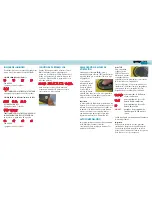
Stay put
- Rescue teams expect you to remain
stationary. Trying to walk for help is generally
not advised and will probably slow down the
rescue effort.
on foot
If you must walk for help, ensure the SafeLink
SOLO antenna remains vertical.
Aircraft
A PLB is often used as an additional carry-off
safety device. The PLB should NOT be activated
aboard an aircraft. The signal will be blocked by
metalwork and the PLB may be damaged by any
impact. Activate the PLB after landing, away from
the aircraft, as it may
cause shadowing.
Vehicles
The PLB will not work well inside a vehicle due to
metalwork shadowing. Exit the vehicle, activate
the PLB, and place it on the roof,
the hood, or just on the ground away from
the vehicle.
Land
Find the best sky view, then place the PLB on
flat ground. Keep the antenna pointing towards
the sky and ensure wind does not knock the
PLB over. Do NOT allow the antenna to sit in a
puddle of water.
Aboard ship
Place the PLB flat on the deck, choosing a position
with the best sky view.
Liferaft
Try to keep the PLB flat and try to elevate the PLB
to avoid bodies blocking the signal. Consider
holding the PLB outside the canopy. First attach
a lanyard between the PLB and your clothing to
avoid loss of the PLB.
Lifejacket
Attach a lanyard cord between the PLB and
clothing to avoid loss of the PLB. Hold the PLB flat
on top of the life vest and try to keep it above
any wave wash. Keep the antenna vertical. Avoid
holding the antenna, or blocking the GPS zone
with your hand.
False alerts
If the PLB has been accidentally activated, or if
rescue has been completed before arrival of the
rescue services:
• Switch off the PLB and notify the appropriate
rescue services or authorities at the earliest
possible time.
• Contact the rescue services, coastguard, or
police by radio or telephone to advise them of
the false alert.
In the U.S. call 1-800-851-3051
In the UK call MRCC Falmouth
+44 (0)1326 317575
gPS PoSItIon AcquISItIon teSt
When testing the GPS, take the PLB outside
into an open space with a clear view of the
surrounding sky.
Self testing of the in-built GPS is restricted to
a maximum of 10 tests throughout the 6 year
storage life of the battery. Once all the tests
have been used up, attempting further tests will
cause the indicator light to flash 4 times in quick
succession and the PLB to power off.
The GPS self-test feature can only be
accessed after first completing a standard PLB
self-test routine;
Push and hold the TEST button for a minimum of
2 seconds, the indicator light will flash once to
indicate the start of the self test sequence. Release
the TEST button.
After a few seconds the standard self-test routine
will complete and should result in the indicator
light flashing a number of times in quick
succession depending on the past battery usage.
Immediately after the indicator light stops flashing,
hold down the TEST button for around 30 seconds.
The GPS test routine starts when the indicator
light begins to flash, now release the TEST button.
The light will continue to flash slowly for up to 5
minutes; you should continue to watch the PLB
throughout this period.
A successful GPS test is signalled by the indicator
light flashing a number of longer flashes in quick
succession.
Important
To preserve battery life, GPS testing is restricted
to a maximum of 10 tests throughout the 6 year
battery life. Once used up, further GPS tests are
prohibited.
chooSIng the BeSt LocAtIon
The SafeLink SOLO works best under an
unobstructed view of the sky. This ensures the
emergency alert message reaches the satellite
system and gives the GPS receiver the best signals
to work with.
If it’s not possible to pick a location with
an unobstructed view of the sky, then try to
maximize the amount of sky available.
Tree canopy degrades performance. Find a
clearing with as much sky view as possible.
Ravines, canyons, caves and overhangs should be
avoided if at all possible.
GPS self test pass
10 – 4 GPS tests remaining
GPS self test pass
3 – 1 GPS tests remaining
GPS self test pass
No GPS tests remaining
11







































